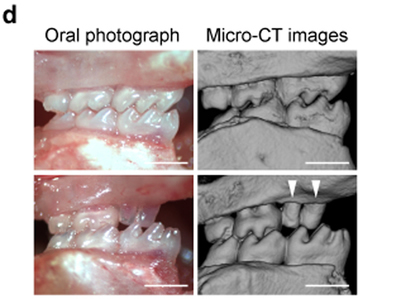|
|
How to multiply teeth!
Teeth are a major target of regenerative medicine. Research has now found a way to — literally — multiply their number. Testing in mice, researchers extracted teeth germs — groups of cells formed early in development that grow into teeth, split them in two, and then re-implant them into mice jaws to develop into fully functional teeth.
Researchers from the RIKEN Center for Developmental Biology, working with colleagues from the Tokyo Medical and Dental University, According to Takashi Tsuji, the leader of the team, approximately 10 percent of people are born with some missing teeth, and in addition, virtually all people lose some teeth to either accidents or disease as they age.
Remedies such as implants and bridges are available, but they do not restore the full functionality of teeth. Growing new teeth would be beneficial, but unfortunately humans only develop a limited number of teeth germs, the rudimentary cell groups from which teeth grow.
"We wondered," says Tsuji, "about whether we might be able to make more teeth from a single tooth germ."
The research group focused on the fact that teeth development takes place through a wavelike pattern of gene expression involving Lef1, an activator, and Ectodin, an inhibitor. Cell signaling centers control the wave of molecules regulating tooth development.
To manipulate the process, scientists removed teeth germs from mice and grew them in culture. After around 14.5 days of mouse development, the tooth germs were sliced in two using nylon thread, then continued to be cultured. The scientists hoped that cell signaling centers, which control the wave of molecules regulating tooth development, would now activate. Which worked. The ligated tooth germ developed into two teeth. The team then transplanted these two teeth into holes drilled into the donor mouse jaw.
The teeth became fully functional, allowing the mice to chew and feel stimulus. However, the new teeth were only half the size of normal teeth, with half the number of crown points — reflecting that the inset teeth were half the volume of an original tooth germ.
Significantly, scientists were able to manipulate the teeth using orthodontic like braces, as the jaw bone properly remodeled to accommodate movement of the teeth.
"Our method could be used for pediatric patients who have not properly developed teeth due to cleft lip or Down syndrome. Particularly as the germs of permanent teeth and/or wisdom teeth [of that patient] could be split and implanted. In the future, we would also consider using stem cells to grow more germ teeth cells. But today, there are barriers to culturing such cells which need to be overcome."
Takashi Tsuji PhD, team leader, the Research Institute for Science and Technology, Department of Biological Science and Technology in the Graduate School of Industrial Science and Technology, Tokyo University of Science, Noda, Chiba, Japan.
The research was published in the Dec. 17, 2015 edition of Scientific Reports, an online journal of Nature.
Abstract
The tooth is an ectodermal organ that arises from a tooth germ under the regulation of reciprocal epithelial-mesenchymal interactions. Tooth morphogenesis occurs in the tooth-forming field as a result of reaction-diffusion waves of specific gene expression patterns. Here, we developed a novel mechanical ligation method for splitting tooth germs to artificially regulate the molecules that control tooth morphology. The split tooth germs successfully developed into multiple correct teeth through the re-regionalisation of the tooth-forming field, which is regulated by reaction-diffusion waves in response to mechanical force. Furthermore, split teeth erupted into the oral cavity and restored physiological tooth function, including mastication, periodontal ligament function and responsiveness to noxious stimuli. Thus, this study presents a novel tooth regenerative technology based on split tooth germs and the re-regionalisation of the tooth-forming field by artificial mechanical force.
Return to top of page
|
|
|
Jan 1, 2016 Fetal Timeline Maternal Timeline News News Archive

Images on left of the occlusion of normal (upper) and split (lower)
mouse teeth. Right column are micro-CT images. Scale bar, 500 μm.
Image Credit:
RIKEN Center for Developmental Biology
|
|
|
|



